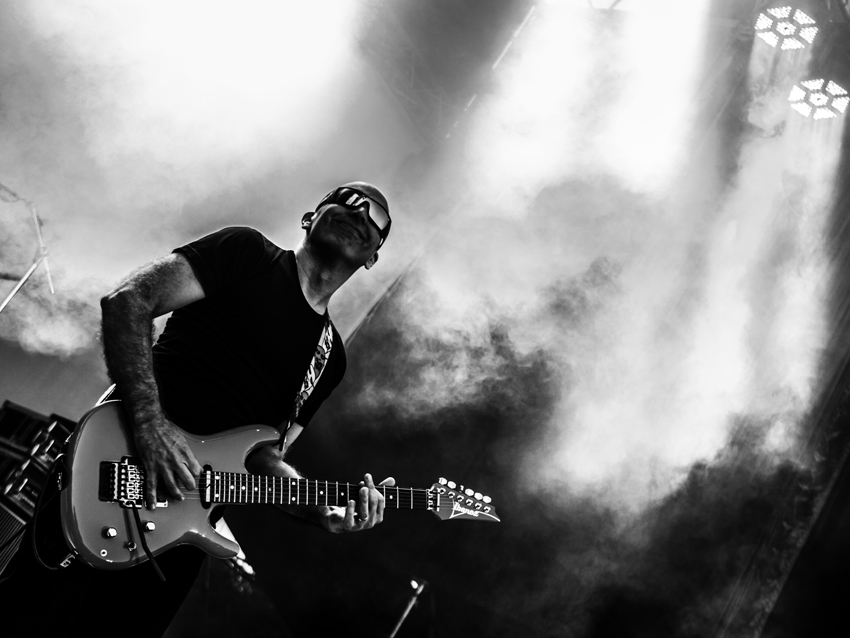
Joe Satriani's top 5 tips for guitarists
Joe Satriani promises some surprises on his upcoming 15th solo album, slated for release this July. Since mid-January, the guitar star has been recording tracks at Skywalker Sound in Lucas Valley, California, and at 25th Street Recording in nearby Oakland with bassist Bryan Beller, drummer Marco Minnemann and keyboardist-guitarist Mike Keneally, and Satriani says that his new music is taking him into areas he's never gone before.
"There’s a lot of playing that advances things both technically and melodically," Satriani says. "From a guitarist's point of view, it's fun to hear new ground being broken. The melodies are really strong, and the arrangements push them into really cool and unexpected places. What I wanted to bring in was the high-energy performance level of Marco and Bryan along with the unpredictable musicianship of Mike Keneally. It’s a really exciting dynamic.”
Perhaps the biggest surprise of the new album is the linking of the music to a full-blown concept – a first for Satriani – that ties into an alter ego he's developed named Shockwave Supernova. "I never really made a concept album before," Satriani says, "or maybe it's something that I've done to some extent but never talked about. Crystal Planet [from 1998] had an internal concept that didn’t really need to be discussed to the audience. In this particular case, I had an internal dramatization on stage in Singapore, the last show of the Unstoppable Momentum tour, and I was telling myself, ‘You’ve got to stop playing with your teeth. Every night you’re just scraping the enamel off.’ And it’s true – in the last two years, I must’ve played with my teeth more than I’ve done in my entire life."
As Satriani describes it, his own relationship with the character of Shockwave Supernova is the impetus for the new album. "I had a funny thought that I use this alter ego to kind of push me out there and be a showman," he says, "because that’s not really how I am – I’m usually more the shy, retiring type. Then I had this daydream that Shockwave has come to the end of the road, and the artist that dreamt him up has to retire him. But then he realizes that he really has to turn him into something else, something better. The songs that I’ve been writing over the past two years sort of address that transformation, what this guy Shockwave is thinking. It’s a crazy, funny concept."
All three musicians – Beller, Minnemann and regular touring member Keneally – circled the world with Satriani on the Unstoppable Momentum tour, and the guitarist says that they've developed a musical shorthand that is making the recent recording sessions a breeze. "We don't have to discuss a lot, so that makes things fun and easy," Satriani notes. "These guys bring in a totally different attitude from other people I’ve worked with. I sent them demos 10 days before we went in the studio – I didn’t want them to get too locked into anything – and they’ve been sort of reinterpreting things in the studio, which is what I want. I ask them for different variations on how they think they might want to play something. Most of the time, that new path is what we end of going with."
Beller, Minnemann and Keneally will join Satch on the Shockwave world tour, set to begin in Manchester, England, on November 1. Before then, however, all three will participate in the guitarist's second annual G4 Experience that runs from June 28th thru July 2nd at the Cambria Pines Lodge in Cambria, California. "Bryan and Marco will be there with their band, The Aristocrats, so we'll also have Guthrie Govan," Satriani says, "and we'll also have Animals As Leaders with Tosin Abasi. Wow, that's some lineup!
"It's going to be a real action-packed week. To not only be able to watch the other players, up close and for hours at a time every day, but to be able to talk to them and reach out and touch them, it’ll be pretty amazing for everybody who attends. Tosin and Guthrie are two of the most incredible guitarists around, and Mike Keneally is amazing in his own right. They’re all pioneers at what they do – they’re so different, but they’re also kindred spirits."
In addition to musical ability, Satriani says that he pays particular attention to players' demeanors and teaching styles when choosing participants for the G4 Experience. "These guys are all so kind and open-hearted, so that's a big reason why I wanted them," he says. "Face it: You don’t want some dick up there teaching you how to play something. [Laughs] These guys are very nice people who also happen to be motherfucker players!”
For more information and tickets for the G4 Experience, presented by Dreamcatcher Events, visit g4experience.com. And for Shockwave tour dates, including tickets and VIP packages, visit satriani.com/road. On the following pages, Joe Satrani runs down his top five tips for guitarists.

Only play what you want to play
“Don’t judge yourself while playing. This is something that came from Lennie Tristano. His idea was that if you’re constantly saying to yourself things like, ‘Oh, that’s no good. I should have played the F instead of the F#,' you’re never really living in the moment; you’re not improvising fully and expressing yourself and embracing the idea that music is an art form.
“Now, if your job is to play in a Broadway show, let’s say, and you keep messing up a particular part, then you might want to check yourself and say, ‘Remember, don’t play the F. Play the F#.’ But I’m talking about more of a metaphysical overview of why you play and what you’re trying to get out of being a musician.
“If you’re a guitar player, and especially if you're a soloist, people are counting on you to be off in the stratosphere shredding and coming up with crazy ideas. You can’t really do that if you’re sitting there overthinking what you’re doing and second-guessing yourself. Again, you’re not really in the moment.
“As Lennie would say, don’t be in the subjunctive mode; just play what you want to play. Don’t try to play things that you think would, should and could sound great. Play what you want to play and move on. This is something that’s really important for young guitarists, because as early on as you can, you want to clear out all the guilt and subjunctiveness of the ‘how, why, woulda, shoulda, coulda.’ You’ll get the most fun out of playing that way, and ultimately, the audience will benefit from hearing somebody play like a true artist.”

Never play with pain
“This is extremely important. If you’re whipping out that metronome every day and you’re playing two- and three-octave scales up and down the neck, at some point if you go, ‘Ow! My wrist hurts,’ then you should stop.
“There is nothing to gain from playing into an area of pain. I know the temptation is to think, ‘Hey, my wrist is killing me, but if I keep playing another 15 minutes, I'll be successful and people will like me. I’ll be a big star and will have lots of money.’ It doesn’t work that way.
“Playing scales over and over against a metronome has nothing to do with success. It’s only a task unto itself that rewards you by letting you play scales against a metronome. The better thing would be to say, ‘Oh, my God, I’m feeling a bit of pain. Maybe I should listen to some other music in which people are playing well.’ Absorb good taste. Absorb good examples of great musicians playing the right notes. That, I feel, is much more valuable than hurting yourself.
“If any activity is causing you physical pain, you’re creating a problem that could haunt you for your whole life. I know there are people who only focus on the big brass ring. They think, ‘I want to be like Steve Vai, and I heard somewhere that he once played for 18 hours straight.’ Now, maybe Steve can do that, but the rest of us are mere mortals. [Laughs] So you have to be careful.”

Learn something new each month
“This is an easygoing yet difficult parameter to maintain for practicing. It’s easy, of course, to play something that somebody taught you 10 years ago and to practice it over and over. Every time you play it well, it’s like you’re patting yourself on the back.
“There are warm-ups that are helpful, moving your fingers around and around, getting your timing and coordination together, things like that. But what’s helped me quite a bit is when I’ve said, ‘What song have I heard my whole life, but I don’t know what the chords are? What solo do I really love, but I’ve never actually played it?’ Or maybe it’s piece of music that I don’t really like, but everybody else likes it.
“Interesting things can happen there. That song that I really like, could I play it? Maybe I can’t. [Laughs] Or that song that I don’t like that everybody else does, maybe it’s out of my comfort zone. Maybe I should get down to it and prove to myself that I can play it. There are all sorts of reasons, but hopefully it’s more innocent and driven by the love of music. That’s always the best reason.
“You might say, ‘I am going to learn a new Rolling Stones song each month.’ That’s a band I’ve listened to since I was five years old. They’ve written a million songs, but can I play all of them? If you started naming them at random, could I play them? It’s a good opportunity to give your musicianship a chance to grow, and obviously it’s always beneficial to increase your repertoire. And it’s also great to analyze somebody else’s music – ‘Look how they went from the verse to the chorus. They stuck this little thing in there.’ You start to see that songwriting is an art form unto itself.”

Experience imitating other players
“The long way of saying this is ‘Experience imitating other players and develop an opinion of what you like and don’t like, and then build your sound and style.’ That’s a mouthful, so let’s break it down.
“First off, the experience of imitating other players just on its own is a great thing. When you’re young and you’re playing in cover bands at social functions or in clubs, you're generally called upon to imitate famous players. That’s how you get good work at first. Somebody will say, ‘Hey, can you play this Animals As Leaders song?’ And you go, ‘Sure.’ Bam – you’ve got it. Or they ask for an Eric Johnson song, and on and on down the line. That’s how it goes in those situations. People want to hear music that they know.
“But that’s the opposite of what’s going to get you professional work and fans around the world. Face it: Nobody wants a substitute for Tosin Abasi or Eric Johnson, because they’ve already got the originals; they can go see them in concert when they tour. So it’s a Catch-22 – you become successful in your own little world by imitating other players. I remember in the late ‘70s, if you were a young guitarist and could play like Eddie Van Halen, you were the most popular kid in your town. That’s cool and that’s great, but it’ll only take you so far.
“When you learn to imitate those other players, it’s important at some point to say, ‘This guy’s great, but I don’t like end result as much as I like what that other guy does.’ Maybe you like things a little blusier or more metal or jazzier or whatever. What you like and don’t like is what ultimately winds up in your style, but you have to develop that. That’s what you have to cling to when luck shines upon you and you can show the world your own style.
“Your style is based on your opinion. I know that sounds funny because it has a bit of a negative connotation – an opinion always sounds like you’re ragging on somebody, like you're an elitist. But what I’m saying is, you have to decide what you like and don’t like so you can adjust the engines that make you play what you play. All of your fine-tuning adjustments are based on your own personal opinion.”

Listen to music like a music lover, not like a player
“One of the things that can skew the development of a point of view about somebody’s artistic statements is when you forget that the people who listen to music aren’t playing it. It’s easy to get so caught up in the details of something that you lose the forest for the trees.
“Musicians have to lead dual lives sometimes. As players, particularly when it comes to something we just recorded, we have to put what we do under a microscope: ‘Am I rushing? Am I dragging? Am I in the pocket? Are all of those notes in tune, or am I routinely going flat every time I’m up on that B string on that particular fret?’ On the other hand, most people don’t think of those things when they listen to music. A song comes on and it provokes a reaction: ‘Do I want to feel like this, or do I want to hear something else?’
“That’s normal people stuff. They come home, it’s been a lousy day, they want to put on music to help them. They want to unwind, they want to feel good, they want to celebrate something they just did at work – all that stuff. What they’re not doing is analyzing the music and thinking, ‘Why did the guitarist do that funny thing on the 12th fret?’ That’s the last thing they’ll ever think.
“Guitarists have to learn to step out of themselves and listen to music the way music lovers do. It’s not about the amp, the pedal, whether it was a first take or a 52nd take or whatever. It’s about how that music makes you feel. Always remember that.”
Joe is a freelance journalist who has, over the past few decades, interviewed hundreds of guitarists for Guitar World, Guitar Player, MusicRadar and Classic Rock. He is also a former editor of Guitar World, contributing writer for Guitar Aficionado and VP of A&R for Island Records. He’s an enthusiastic guitarist, but he’s nowhere near the likes of the people he interviews. Surprisingly, his skills are more suited to the drums. If you need a drummer for your Beatles tribute band, look him up.
